Pine
Pine trees are well adapted to low temperatures and dry conditions. They need drained soil to remove excess moisture. The height of the representatives is from 30 to 80 m. Their lifespan is 150-200 years.
The Pine family includes:
Pine
Coniferous forests with pines grow in the Northern Hemisphere. They grow on sandy loams, loams, rocky areas. Their crown can be bush-shaped, columnar, elliptical. Most representatives of the genus Pinus have dark green needles. The branches of the trees are spread out or ascending. The most common species are Scots pine, yellow pine, mountain pine;
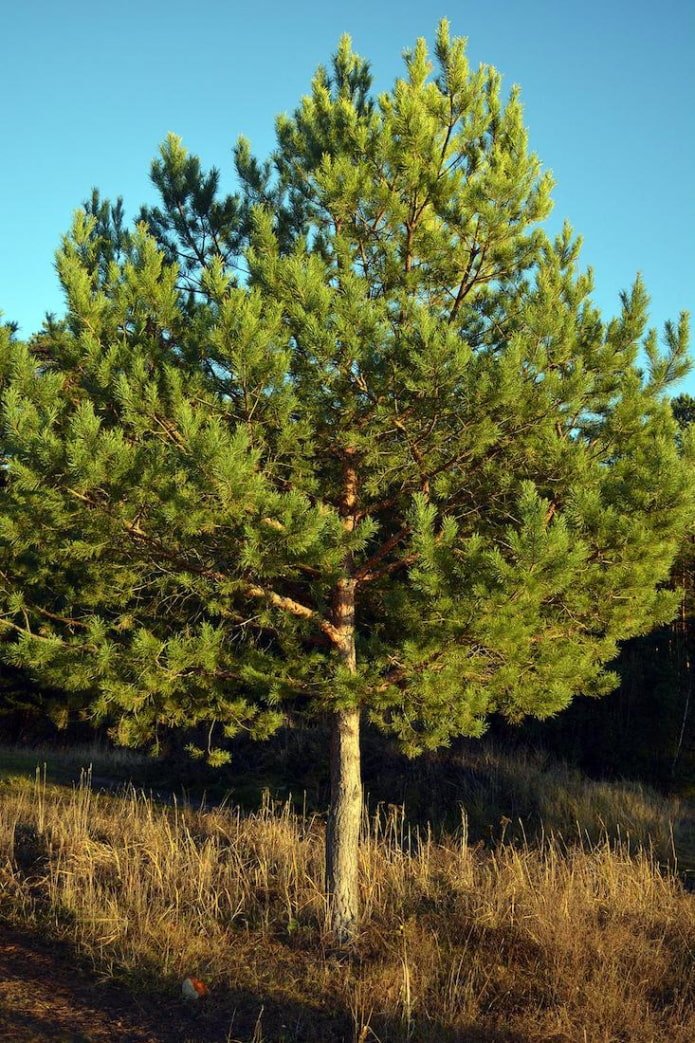
Spruce
In young spruce trees, the main root supplies nutrients. Over time, this function is transferred to the lateral branches of the root system. Because of their close location to the ground, spruce does not tolerate strong winds. The tree prefers soil with a low pH. To form an aesthetic crown, it needs good lighting. Otherwise, the spruce will be asymmetrical.
The trunk of the tree is covered with gray bark. Its sharp needles can be gray, blue, glaucous and dark green. Spruce can reach 40 m in height. Its lifespan in the forest is about 3 centuries. The length of spruce cones is about 15 cm. Popular species are prickly spruce, Norway spruce, silver spruce;

Fir
Fir grows in taiga forests. It grows well in clean areas on loams and shaded areas. This coniferous species does not like wind, drought, high temperatures and polluted environment. Its branches are arranged in a ring-horizontal pattern.
Fir bark contains a large amount of tannins. The tree’s needles are renewed every 10 years. The fir bears fruit in the fourth decade of its life. This evergreen plant lives 400-700 years. It has medicinal properties. Common varieties are Caucasian, Korean, and balsam fir. Summer residents prefer dwarf varieties of this tree;
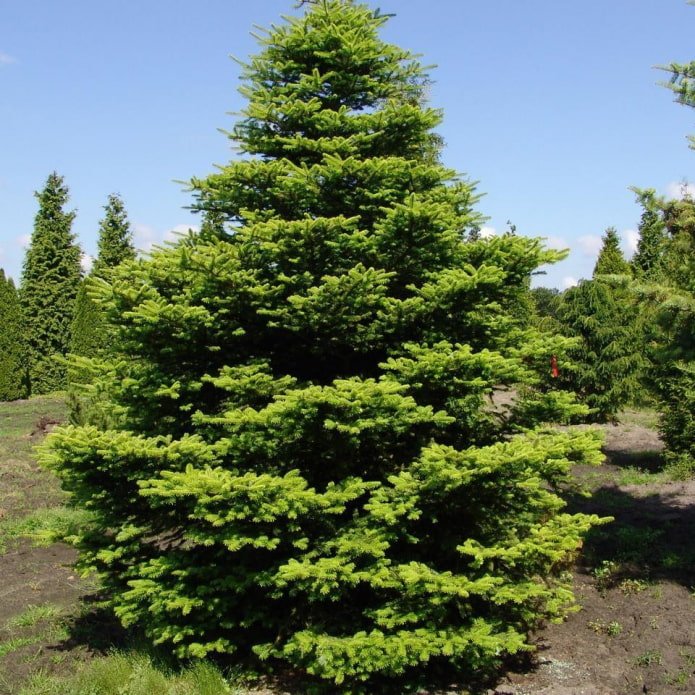
Cedar
Cedar grows in taiga forests. Its needles are collected in bunches. The tree has scaly bark and prickly needles. The vegetation period of cedar lasts 1.5 months. It grows slowly. The second name of cedar is Siberian cedar pine.
The soil for the tree should be loose, drained and have a neutral pH. It requires high humidity and timely fertilizing. Cedar branches need regular pruning. Among the species are Himalayan, Lebanese and Atlas cedar;
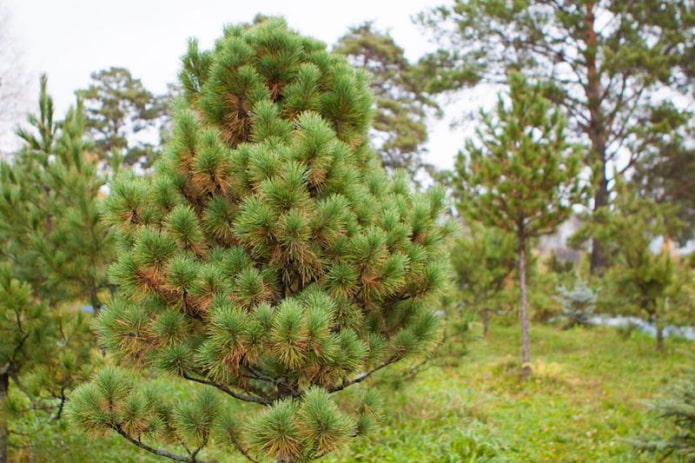
Keteleeria
Grows in the southern regions of Russia. This exotic coniferous tree can live up to 1200 years. Keteeleeria is a monoecious plant. Its cones ripen in winter. The plant is often grown in botanical gardens;
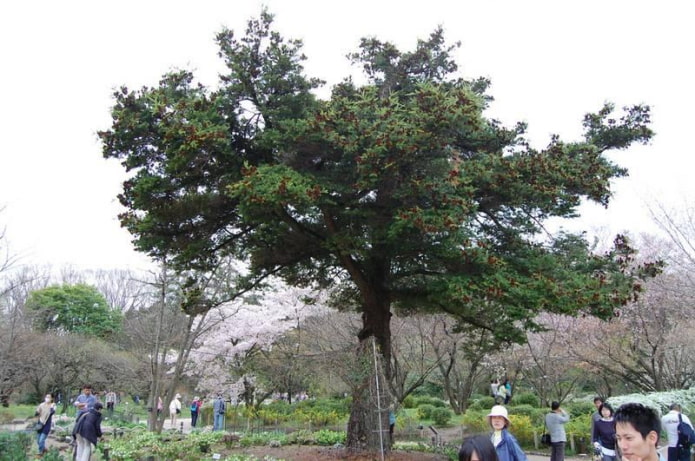
Larch
Larch grows in European forests. In winter, it sheds needles from its branches. The tree is highly resistant to low temperatures. It can withstand temperatures as low as -70 degrees. But it does not tolerate low light.
Larch has branches with needles arranged in a spiral. Flat scales are visible on the cones. Young trees have a conical (cone-shaped) crown, while adults have an ovoid crown. The bark of the tree has bactericidal properties
Larch requires fertile, drained soil with neutral acidity. This tree tolerates pruning well. Its lifespan is about 500 years. The height of the tree can reach 30 m. The trunk diameter is about 1 m. Modern varieties of larch are suitable for growing in containers;
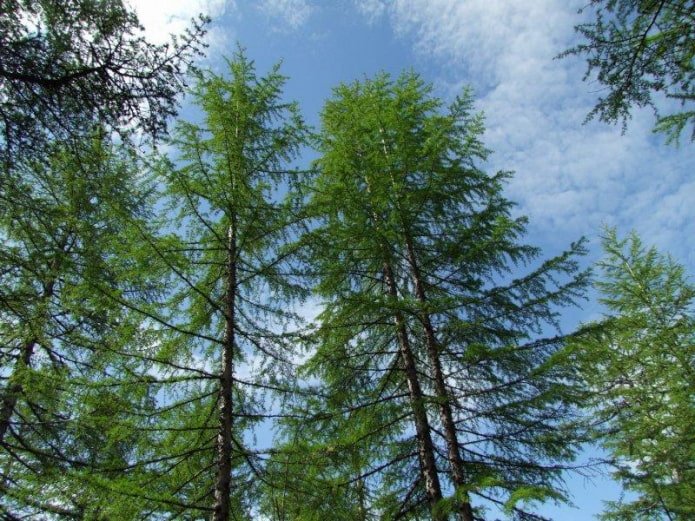
Tsuga
Representatives of the genus Tsuga are found in eastern North America. Sandstone or sandy loam is suitable for growing them. Tsuga grows well in semi-shaded areas. It does not tolerate high levels of impurities in the air.
The plant has spreading branches. The needles are located on the branches in 2 rows. The height of the tree is from 5 to 30 m. This evergreen plant is suitable for decorating suburban areas.
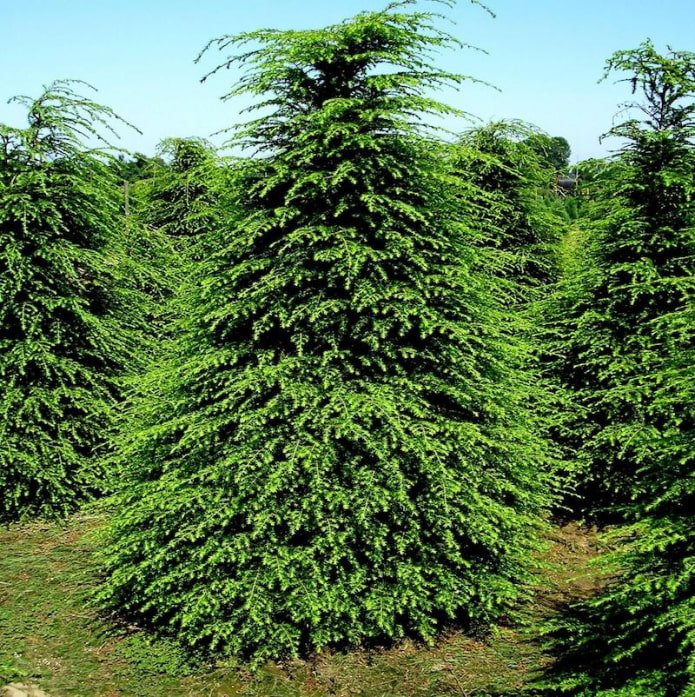
Shrubs are rare among the Pine family. All representatives of the family are characterized by a slender trunk and leaves modified into sharp needles.
Cypress
Cypress conifers grow in warm areas with a tropical or subtropical climate. They can be found in both the Northern and Southern Hemispheres.
The following genera belong to the Cypress family:
Cypress
Cypress has an elongated green crown, complemented by light brown cones. It is characterized by rapid growth. With age, the bark of the tree becomes harder. Cypress leaves have a needle-like shape. Later, they become covered with scales.
Cypress should be grown in the shade. Timely watering, loose soil, suitable fertilizing and high air humidity are important for this evergreen tree. It can withstand temperatures down to -20 degrees.
The smell of cypress can repel pests and other insects. It is better to choose dwarf varieties for a summer residence. They will be easy to cover for wintering;
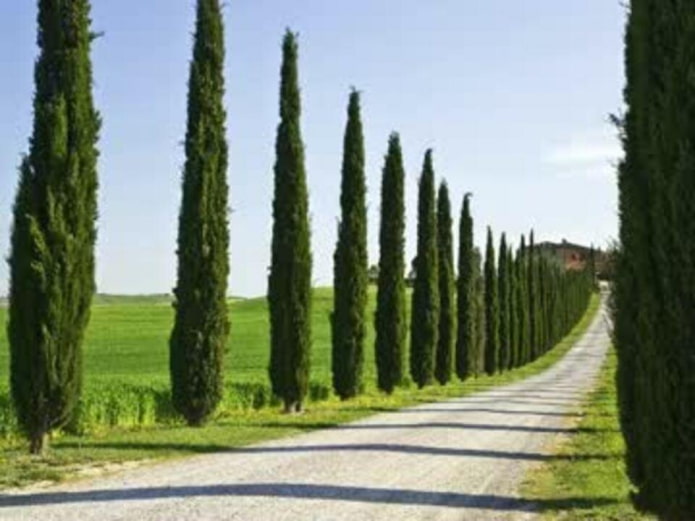
Thuja
The second name of the thuja is the Life Tree. Its height is up to 70 m. Young representatives have soft needles, but over time they become scaly. The bark of the thuja is colored red or brown.
The tree easily tolerates winter cold. But in the cold season it needs to be covered and periodically shaken off the snow. With high-quality drainage, this coniferous plant tolerates drought, rain, shade. It can be easily given a beautiful shape. Most often, the plant has a spherical, rectangular, spherical, horizontal, pear-shaped, columnar crown shape. Thuja bears fruit every 3 years;
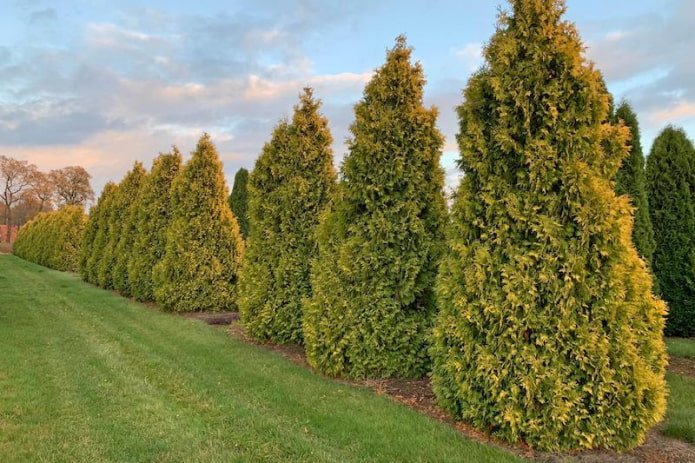
Cryptomeria
Another name is Japanese cedar. Cryptomeria grows in humid and warm climates. The needles are located on the branches in a spiral. They are light green. The diameter of the trunk of the plant is up to 2 m. It is covered with fibrous bark of a reddish hue. The crown has a pyramidal shape. This evergreen plant is used for ornamental purposes;

Juniper
In the warm climates of the Northern Hemisphere, juniper looks like a bush with spreading branches. In cold areas, it becomes a miniature coniferous plant. Juniper has a tree-like, bush-like, creeping crown. It produces small blue cones that resemble berries. The bark of juniper is brown-red. It requires loose soil with dolomite and good lighting.
Popular species are scaly juniper, virginian juniper, and juniper multi-fruited;
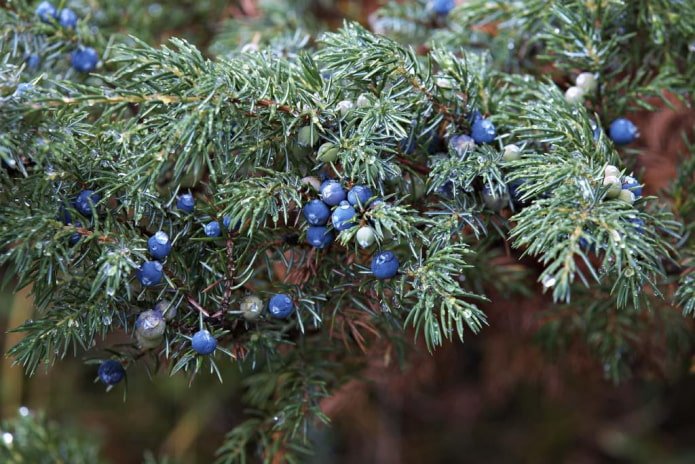
Callitris
Callitris grows in the tropical zone. It has scaly needles and an ovoid or spherical crown. Callitris cones ripen within one and a half years.
This coniferous plant is grown in botanical gardens. Due to the complexity of care, it is rarely planted in plots;
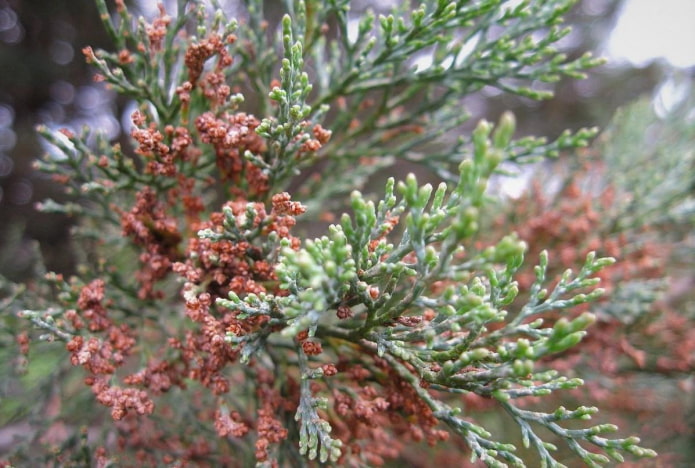
Cypress
The maximum height of the cypress is 1.5 m. It is suitable for small, well-lit places. In young specimens, the needles look like needles. With age, they become scaly. The branches of the cypress are smaller than those of the cypress. The tree is characterized by a conical (cone-shaped) crown. Its cones contain 2 ovules. The cypress quickly adapts to new conditions. For the winter, it must be removed to a warm place.
This plant can be grown in tubs. Due to its compact size, this evergreen tree is in great demand among summer residents.
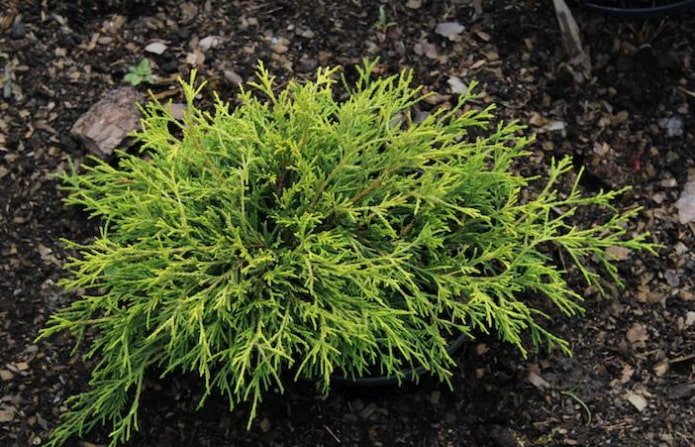
Cypresses are dioecious plants. They can be propagated by cuttings. The family includes both trees and shrubs.
Yew
Yew coniferous trees and shrubs grow in the Northern Hemisphere of the Earth. Their lifespan is more than 2,000 years.
Yew needles are toxic to animals. Their litter can destroy seeds that have fallen into the ground.
The family includes 2 genera:
Yew
Yew is a frost-resistant tree. It is undemanding to lighting. It has branched roots. Drought, windy weather, stagnant water, polluted environment, acidic soil are unfavorable for yew. It does not emit essential oils and has no smell. Yew leaves have an elongated shape. It produces fruits in the form of berries. The roots and shoots of the plant are poisonous. It is propagated by seeds.
In nature, yew grows up to 10 m. But breeders have managed to develop miniature varieties up to 100 cm high. Yew helps prevent shrubs from freezing in the garden;
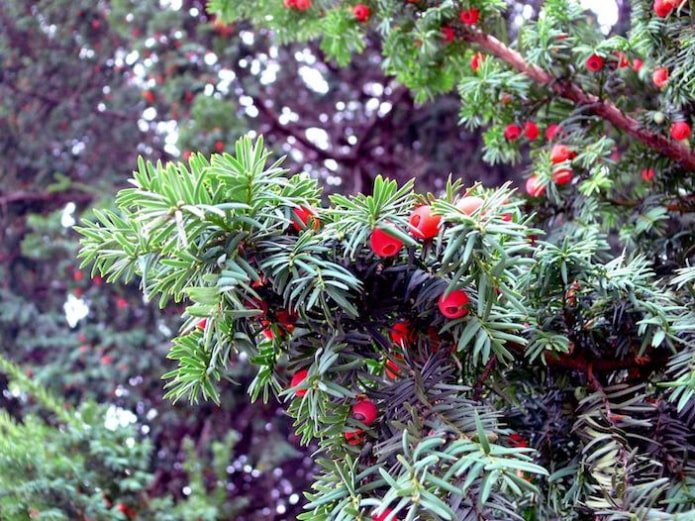
Torrea
Torrea grows in the Caucasus. Its needles are arranged in a spiral. Torrea can be both dioecious and monoecious. The cones, stems and needles of this tree have a specific smell. All types of soil are suitable for Torrea. However, it is important not to allow it to become acidic. The tree needs good lighting and maximum protection from the wind. And in winter, it is necessary to mulch the trunk circle with organic matter.
Torreya is capable of producing a rich harvest of nuts. Varieties of this tree with variegated needles are suitable for summer cottages.

Representatives of the Yew family are characterized by hard leaf blades on linear or lanceolate branches. They do not have sharp needles.
Araucariaceae
Conifers from the Araucariaceae family grow in the southern hemisphere. They live in humid forests of the tropics and subtropics.
The Araucariaceae family includes:
Araucaria
Araucaria is suitable for home keeping. In nature, it grows in South America and Australia. It does not tolerate low temperatures. It grows well in diffused light. This dioecious plant can change sex during its life. Female cones of the tree are round, and male cones are elongated.
Araucaria is actively used in the decoration of garden plots. The maximum height of its miniature varieties is 2 m. And in natural conditions, the length of the tree trunk is 30-70 m. Araucaria seeds are used in cooking;
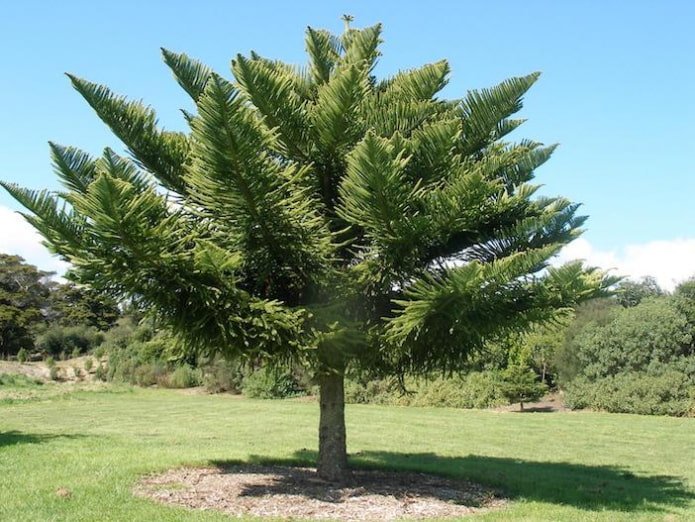
Sequoia
Sequoia is considered the oldest tree in the world. Its height is 70-100 m. The lifespan of sequoia is over 3,000 years. The tree grows in North America. Its trunk diameter can reach 9 m.
When there is a lack of moisture, sequoia sheds its branches. The crown of this tree has a conical shape. Its trunk is covered with fibrous soft bark. The branches are located horizontally. Young sequoias have flat leaves, while adult sequoias have arrow-shaped leaves. In the light, scales are visible on them. The cones are small. The plant reproduces by seeds, cuttings and shoots.
Sequoia can be grown indoors in the bonsai style. It needs humid air and well-moistened soil;
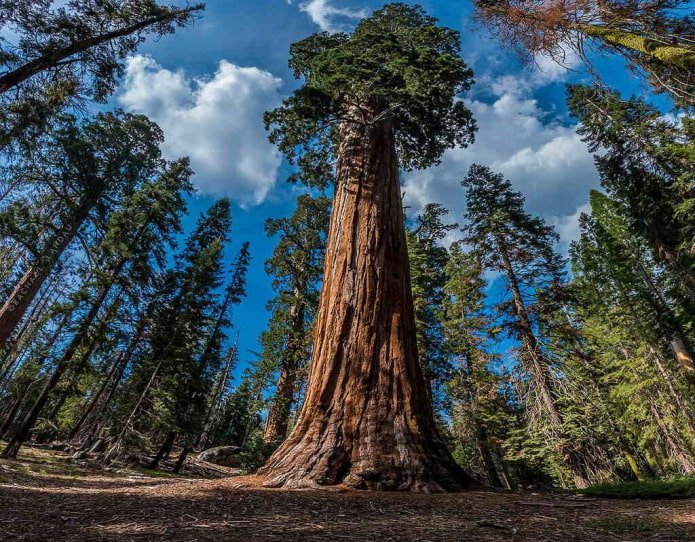
Agathis
Agathis is a shade-loving coniferous plant. It is resistant to drought conditions. Agathis requires loose, drained loam in a spacious, windless area. The plant can withstand temperatures down to -20 degrees Celsius. It has large leaves with parallel venation. The plates have a variety of shapes – acute, ovoid, ellipsoid, lanceolate. Their length can reach 18 cm.
Agathis is characterized by large green cones with a diameter of about 15 cm. In the natural environment, the trunk of this tree can grow up to 80 m.
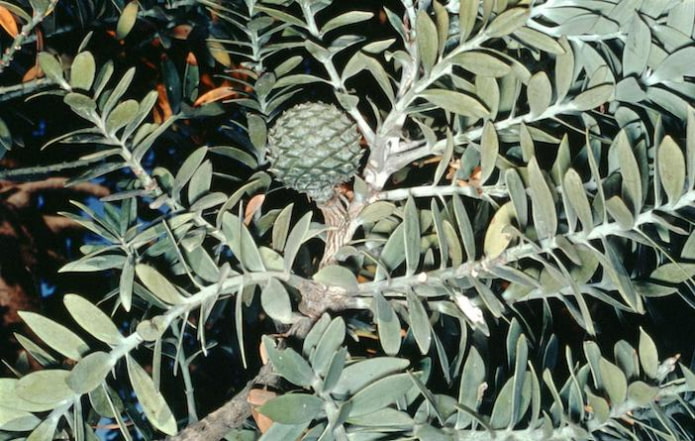
The bark of Araucariaceae contains tannins and resin. These trees require high humidity.
Podocarpaceae
The name of the family is translated as “polycarpous”. Its representatives grow in tropical, subtropical and temperate climates. They do not tolerate severe frosts. They love high humidity. The family includes shrubs and trees.
The Podocarpaceae include:
Podocarpus
It lives in Africa, South America, and some Asian countries.
Podocarpus is characterized by leathery leaf blades of a belt-shaped, ovoid, or oval shape. They are arranged spirally on the branches. With age, the shoots of podocarpus become woody. This coniferous plant bears berry-like fruits of red, purple, or blue color. They can be eaten in small quantities.
The tree grows slowly indoors. It is easy to shape the crown. It is suitable for open ground, and also as an ampelous (indoor) plant.
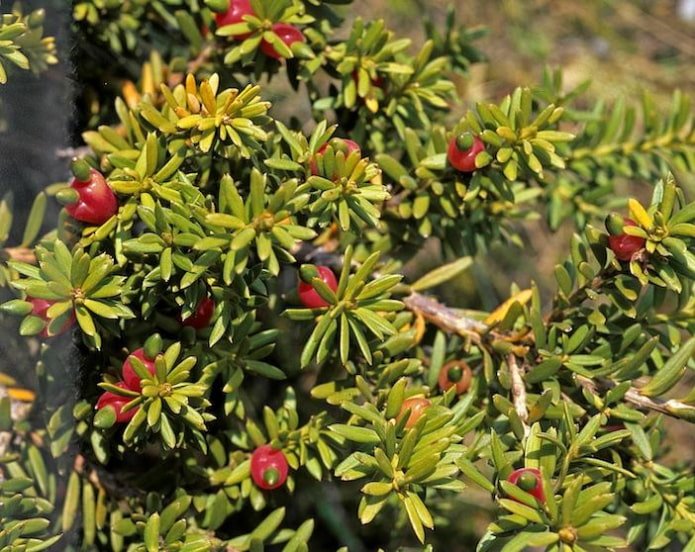
Plant Parasitaxus
A small branched tree with purple coloring and white balls on the branches. It is the only parasite among conifers. It grows in New Caledonia.
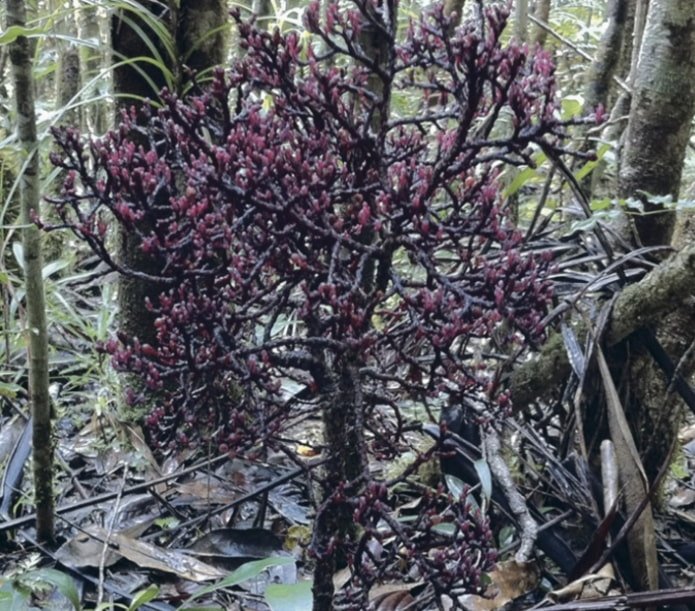
Conifers and ephedra are not synonyms.
Conifers include shrubs and small trees of the genus Ephedra. Their branches function as leaf blades. They fall off quickly. Conifers are characterized by the formation of cones. But such plants do not have high decorative value. In Russia, it is prohibited to grow conifers, since they are used to create narcotic substances.
Classification by size and shape
By shape and size, conifers are classified as tall, creeping and dwarf.
Tall
Tall conifers are suitable as an accent in the design of the site. Their size reaches several meters.
Tall conifers include:
Serbian spruce
Serbian spruce grows up to 40-45 m. The scales of its cones change from blue to brown over time. The plant is resistant to lack of sun, frost, polluted air. But it reacts negatively to lack of moisture;
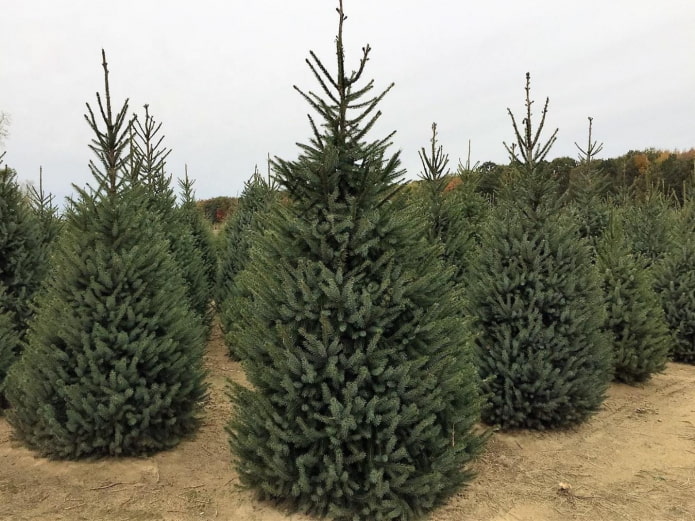
Thuja Smaragd
The height of the Smaragd thuja is up to 5 m. With insufficient lighting, the color of the needles on its branches becomes dull. The plant requires regular watering. Its lifespan is about 100 years;
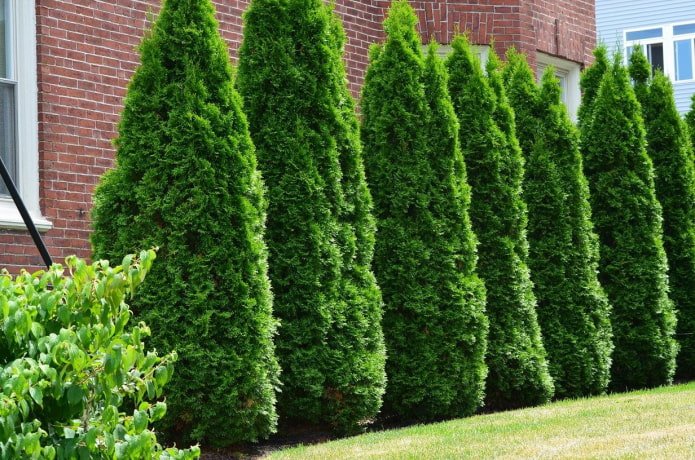
Abies concolor
This is a pyramidal variety of fir. It has long dark green needles. The cones are purple. The one-color fir prefers loams or sandy loams. The plant has high adaptive properties;
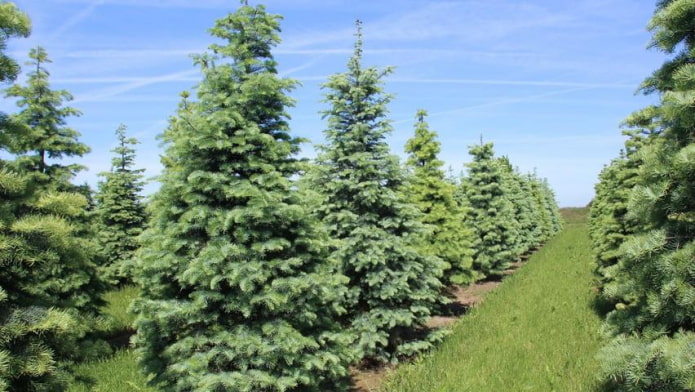
Thuja Brabant
Thuja Brabant grows up to 3.5 m. It has a narrow pyramidal crown. The plant is used to form a hedge. It loves moisture, as well as sunny and shaded areas.
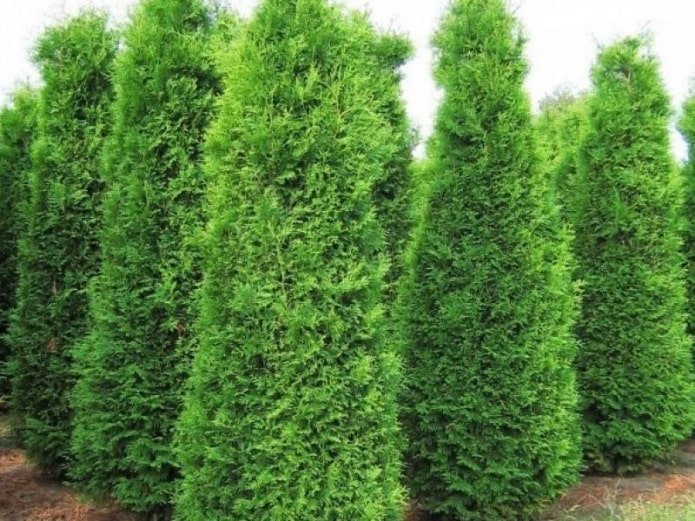
Creeping
Creeping conifers are used to decorate borders.
These include:
Canadian hemlock
This is a slow-growing shrub. It prefers partial shade and moist, slightly acidic soil. The plant does not respond well to drought. It is highly frost-resistant. The cones are spindle-shaped.
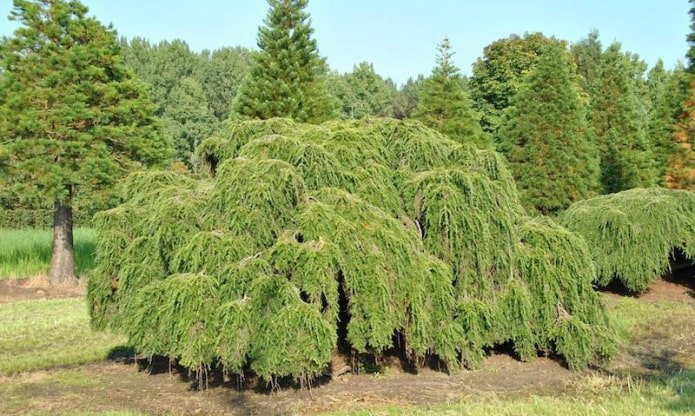
Juniper Green Carpet
A creeping shrub with soft, pale green needles and horizontal branches. Their interweaving creates a dense coniferous cover. Juniper Green Carpet grows on sandy and calcareous soil;
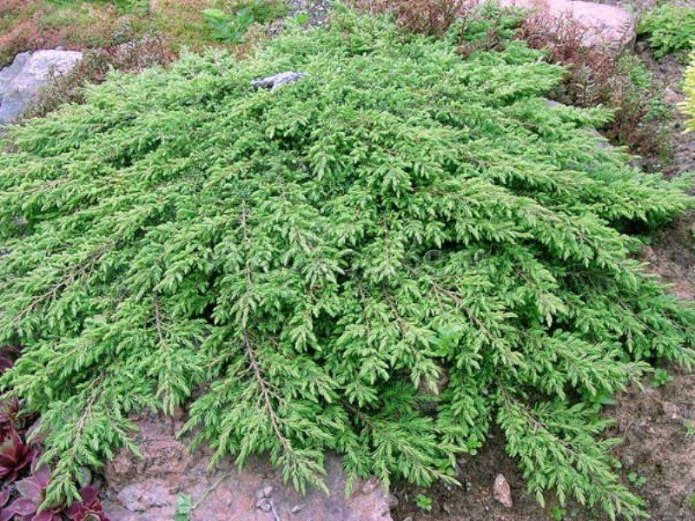
Spruce Lorelei
This variety of spruce requires grafting in the root collar area. Otherwise, the plant will not be able to spread. Spruce Lorelei grows in sunny places on drained loams or sandy loams;
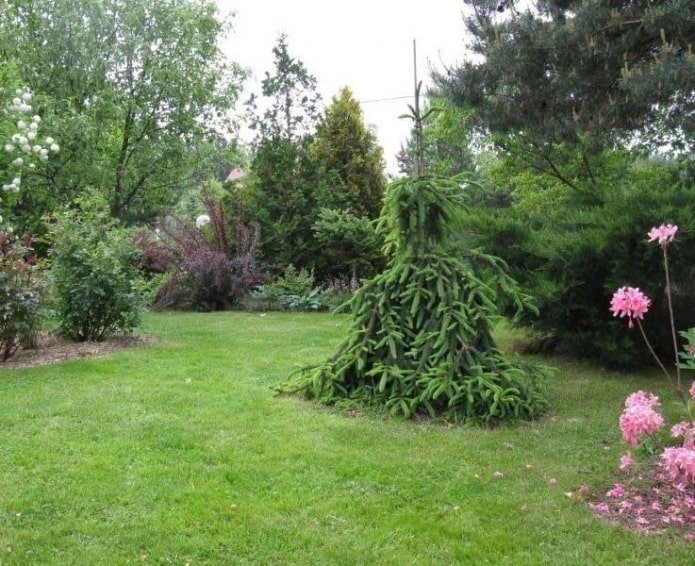
Juniper Prince of Wales
Resistant to frost. In winter it has a bronze color, and in summer it becomes bluish-green. This creeping, spreading bush is often used for decorative purposes.
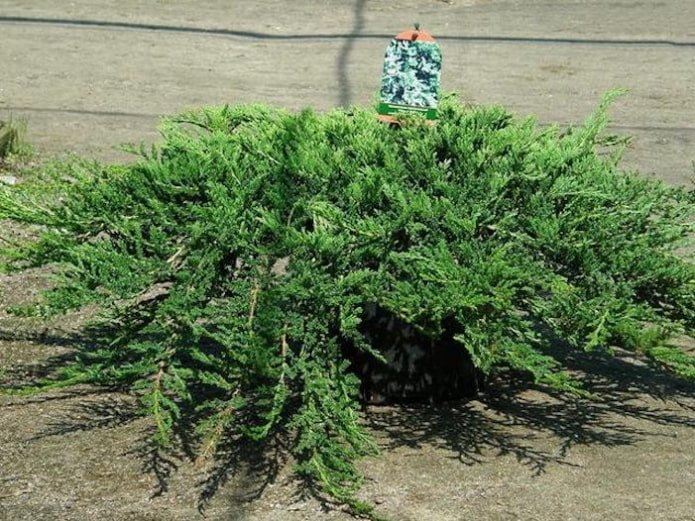
Dwarf
Dwarf conifers are used to decorate rooms or small areas.
This group includes:
Thuja Danica
A coniferous tree with a spherical crown. It has a slow growth rate.
In summer, the needles of the thuja are green, and in winter they are brown. In the cold season, the plant should be covered. It is prone to burns when exposed to direct sunlight. Thuja Danica reacts negatively to drafts;
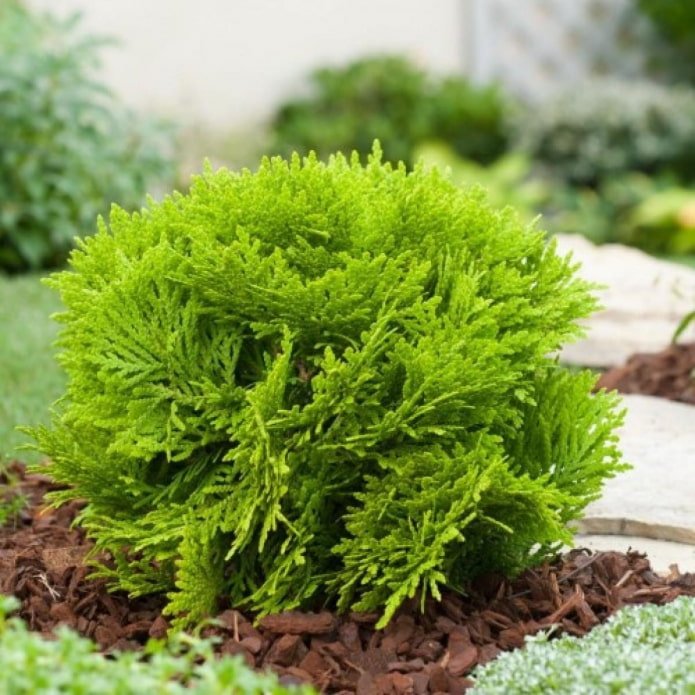
Mountain pine Mini Pug
This variety needs good lighting. It is resistant to winds and low temperatures. Unpretentious to the soil. The cones of the mountain pine Mini Pops are gray-brown. They ripen in about 2 years.
The tree branches are covered with 3 cm long needles. The crown of the mountain pine requires artificial formation of a spherical shape;
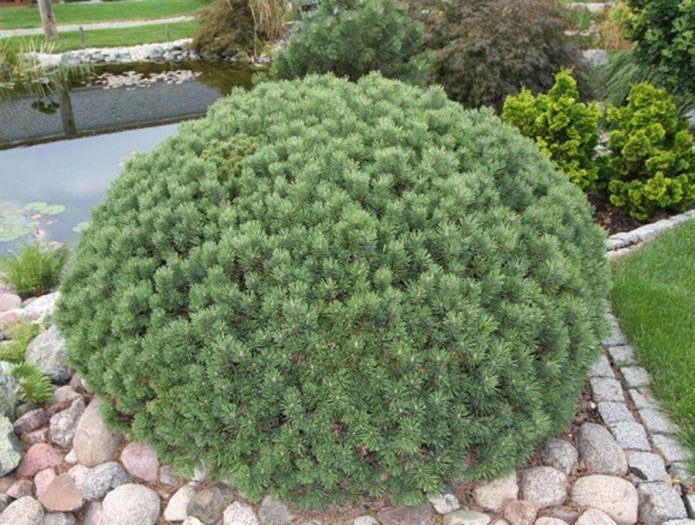
Konika spruce
The spruce has dense pale green needles. Does not require crown correction. The Konika spruce requires neutral or slightly acidic soil. It reacts negatively to excess moisture in the soil. Young representatives of this species need to be shaded, and mature ones should be kept in the sun. Spruce cones are brown;
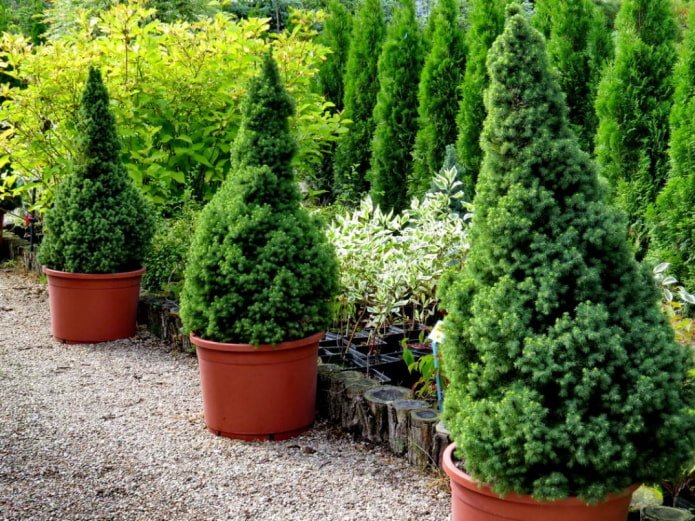
Pine Compacto Glauca
This is a cedar pine with a pyramidal crown and bluish-green needles. It prefers moderately moist soil with neutral acidity. The length of the plant cones is 6-8 cm.
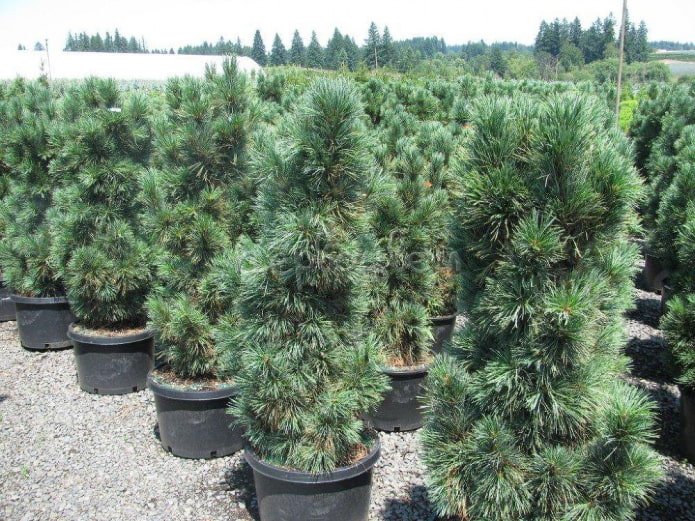
What species can be grown in the middle zone?
Not all species of conifers can be grown in the middle zone. Its climatic conditions will be favorable for Pinaceae, Yew, Podocarpaceae.
Species and varieties of evergreens for growing in a temperate climate:
Thuja occidentalis (variety Khoseri)
Thuja occidentalis has a spherical crown and dark green needles on the branches. It grows slowly. It tolerates winter colds well. It has small cones;
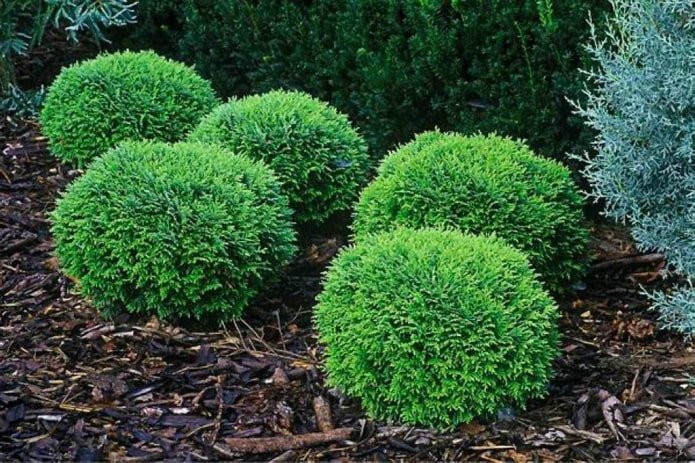
Yew berry canadian
It has a conical crown and light or dark green needles. Its berries are not suitable for consumption. The length of the needles is 20-30 mm;
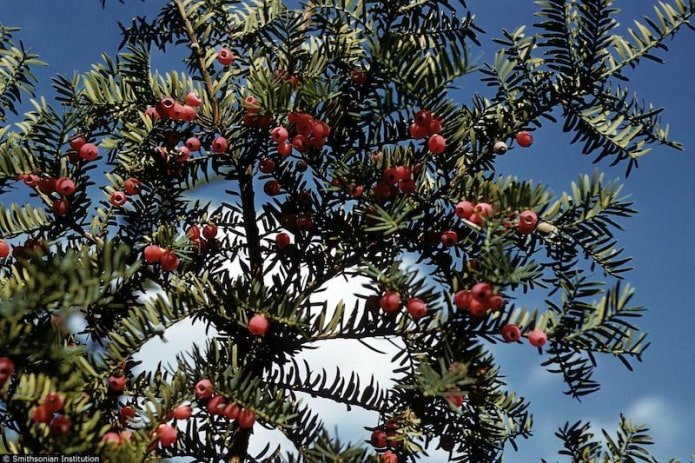
Nootka cypress (variety Variegata)
It is characterized by a yellow-green color and a pyramidal crown shape. The cones of the plant are grayish or brown. They ripen within 2 years;
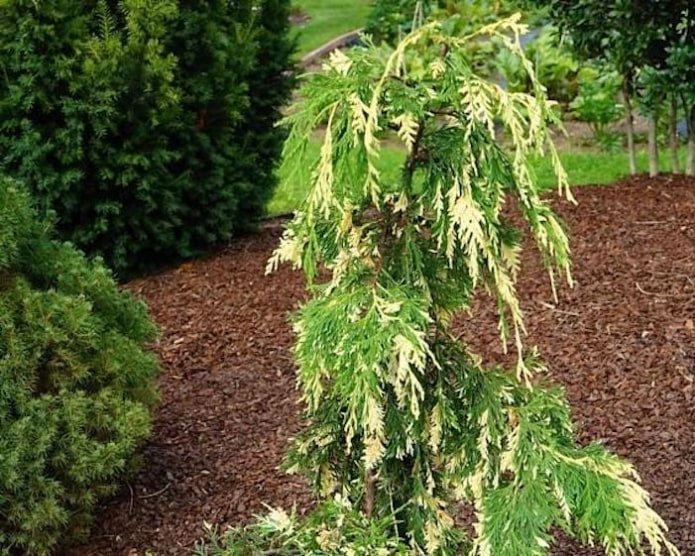
Korean fir
It has a conical crown. The needles of the Korean fir can be white, blue, silver or dark green. The cones grow by the age of 10. At first they are green, and after ripening they acquire a purple or blue color. The plant is unpretentious and resistant to cold.

Thanks to modern achievements in selection, you can successfully grow evergreen plants in your garden. They do not require complex care, improve air quality and bring a lot of aesthetic pleasure.
Now reading:
- Discover the All-New Mazda 2: A Perfect Urban Ride
- Make Your Own Storage Boxes: 8 Detailed Tutorials with Photos and Videos
- Macrame in the interior: 58 photos with ideas and approaches to design
- Loft Bed: 77 Interior Photos, Ideas for Children’s Rooms and Bedrooms
- Liquid wallpaper in the kitchen: advantages, disadvantages and design ideas (29 photos)